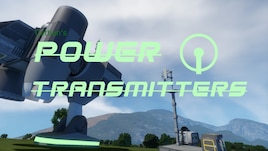Install Steam
login
|
language
简体中文 (Simplified Chinese)
繁體中文 (Traditional Chinese)
日本語 (Japanese)
한국어 (Korean)
ไทย (Thai)
Български (Bulgarian)
Čeština (Czech)
Dansk (Danish)
Deutsch (German)
Español - España (Spanish - Spain)
Español - Latinoamérica (Spanish - Latin America)
Ελληνικά (Greek)
Français (French)
Italiano (Italian)
Bahasa Indonesia (Indonesian)
Magyar (Hungarian)
Nederlands (Dutch)
Norsk (Norwegian)
Polski (Polish)
Português (Portuguese - Portugal)
Português - Brasil (Portuguese - Brazil)
Română (Romanian)
Русский (Russian)
Suomi (Finnish)
Svenska (Swedish)
Türkçe (Turkish)
Tiếng Việt (Vietnamese)
Українська (Ukrainian)
Report a translation problem










So the power drop off to relay is allot less and then from relay to receiver same as now.
Like transxxxxxxxxxxxxreciever
To. Transxxxxxrelayxxxxreciever
It would cost the least to construct of any power transmitter, but it would have the lowest performance in terms of power transmission, range, and efficiency. IRL this technology is limited to extremely short ranges, so the power transmission would fall off by 1/R^4 or worse, instead of 1/R^2.
The intended niche of this type of power transmitter is charging of small ships from the hangar bay or decks of a large ship, with the transmitter embedded in a floor, wall, or ceiling of the hangar.
Proposed Specifications;
It would be able to send its rated power out to ~50m from the transmitter block (20 large-ship blocks), because 20 large-ship blocks should be more than enough to cover a hangar bay that can fit one small- to normal-sized small ship.
Hopefully the very short range also helps with performance because the transmitter can't transmit power very far at all, which would make avoiding the calculations related to overlapping networks much easier.
Power doesn't currently transfer across landing gear connections, altho I very dimly remember something like that being talked about in the past.
According to tests I've done recently it doesn't work.
Why? possibility to add fitting sounds, see if it's turned on, reactor-tubes
Power Stealer
Automatically, but slowly, hacks into a nearby (within 1/4 of the range to) Transmitter/Reciever to get the channel, and disguises itself as one (digitally) to feed off the power and eventually shut down the transmitter/reciever. However, this is counteractable. If a transmitter/reciever's pilot notices the hitchiker, they can cause it to overload by putting a single string into the name of the T/R, causing the Stealer to rupture, and cause mass damage to all electronic components in the grid it is on, such as, solar panels, turrets/weapons (causes them to self destruct (missile or other low-velocity projectile launcher) or bug out and not function (gatling/bullet/lasers)), cockpits, and programming blocks. None of these are destroyed (except missile launchers/low-velocity projectile launchers), but their data is wiped, similarly to how a magnet wipes a Solid-State Hard Drive.
Intercepting power should be as simple as tuning a reciever to the right channel (aka frequency), and there's nothing the transmitting station can do about it except turn itself off or changing the frequency it's transmitting on. And it's impossible to detect that as well, due to how radio waves work.
Even intercepting a directional transmitter only changes things to "get inside the beam, then tune to the right frequency". In this case, you can detect the interception because the beam doesn't get to its destination (line-of-sight blocked).
No action the transmitter takes can "burn out" systems on a "intercepting" reciever, unless it would ALSO damage the "intended" reciever.
Magnetic fields are physically NOT ABLE to wipe solid state hard drives. Solid state hard drives use the same kind of chips that USB thumb-drives use, and the data is stored as an electric charge trapped on the gate of a special kind of field-effect transistor.
"Standard" hard drives on the other hand (the kind with spinning disks inside), can be wiped by a relatively strong magnetic field in very close proximity to the disks, because they store the data by changing the orientation of magnetic fields in the disks.
Conrary to the song by ICP, engineers know EXACTLY how magnets work (and how they DON'T work, too).